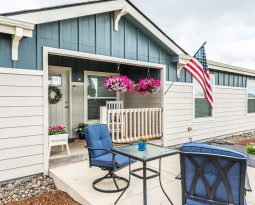EXPOSED! Top 5 Driving Forces Behind Manufactured Home Affordability
Affordability is cited by 71% of residents as being the driving force for choosing a manufactured home according to the Manufactured Housing Institute (2019).
How affordable are they? A comparison between the average cost of a site-built construction in 2019 was $111 per square foot, compared to $50 per square foot cost of a new manufactured home comparably equipped and sited.
Unfortunately, there are those that will not consider a manufactured home, mistakenly believing that a manufactured home must not be built as well as a site-built home, otherwise the sales price would be much higher. That assumption is typically based upon misconceptions, misrepresentations, and prevailing myths associated with “mobile homes” and “trailer houses’’ dating back nearly a half-century ago.
So, what is different now? The efficiency of the construction process and value-added aspects of manufactured homes have evolved, resulting in manufactured housing being equal and often superior to custom site-built homes in every respect, including building materials, quality of construction, energy efficiency, amenities, appearance, enhanced safety in occasions of wind and fire and value appreciation and/or depreciation, with up to 50% of the total cost of the traditional site constructed home.
In addition to the streamlined production process, technological advances, evolutionary designs and a focus on delivering quality homes that families can afford are additional driving forces within the manufactured housing industry. That’s why more people are turning to manufactured homes that fit their needs and wants, at a price they can afford.
The following are the top 5 reasons how savings from the modern manufactured home production process allows more Americans to realize quality affordable homeownership, even in the face of an ever-widening housing affordability gap versus traditional on site-built homes.
(1) EFFICIENCIES OF THE FACTORY BUILDING PROCESS
The affordability gap in comparison to traditional site-built homes is due to the efficiencies of the factory-building process Manufactured homes are constructed with standard home building materials and are built almost entirely off-site in a factory.
(2) CONTROLLED ENVIRONMENT AND ASSEMBLY LINE TECHNIQUES
The controlled construction environment and assembly-line techniques remove many of the problems encountered during traditional construction, such as weather, theft, vandalism, damage to building products and materials, and unskilled labor. Manufactured home factory employees are trained and managed more efficiently than the system of contract labor employed by the site-built home construction industry.
(3) BENEFITS FROM THE ECONOMIES OF SCALE
Much like other assembly-line operations, manufactured homes benefit from the economies of scale resulting from purchasing large quantities of materials, products, and appliances. Manufactured home builders can negotiate substantial savings on many components used in building a home, with these huge savings passed on directly to the homebuyer.
(4) EVOLUTION IN FACTORY BUILT TECHNOLOGY
Today’s manufactured homes have experienced an evolution in the types and quality of homes available to buyers, Technological advances allow manufactured home builders to offer a variety of architectural styles and exterior finishes that heretofore were not available off-site, that will suit most any buyer’s dreams while allowing the home to blend in seamlessly into most any neighborhood.
(5) MEASURABLE SAVINGS IN REDUCED COMPLETION EXPEDIENCY
“Time is money.” Greater flexibility and efficiency of the manufacturing process allows for customization of each home to meet a buyer’s lifestyle and needs and are preplanned before the home begins the construction phase and does not delay completion. Typically, a customized new manufactured home can be built and ready for occupancy on site within weeks, as compared to months for a home built on site. This expediency accounts for much of the savings in becoming a manufactured homeowner.







